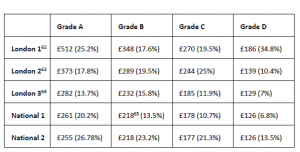GUIDELINE HOURLY RATES WORKING GROUP REPORT FOR CONSULTATION JANUARY 2021
Should the recommendations be accepted? – response required by 31 March 2021 Respond to the consultation online CJC link here
Some thoughts from Katy Manley:
The stated methodology itself is contradictory and the logic flawed to the extent that the rates proposed in paragraph 4.18 appear to arise from a quantum leap bearing little nor no relationship to the narrative and data set out in the rest of the report.
The commercial reality is that consumers of services of litigation lawyers in the current market seek lawyers with expertise that relates to the particular litigation concerned. This report expressly excludes any such assessment. To attempt to compare the way that a personal injury claimant client seeking a ‘no win no fee’ deal with an insurer looking for a panel firm in terms of hourly rates is an impossible task which should either never have been attempted or at best should have been properly addressed.
The number of responses received from the exercise set out in the Appendices has been omitted from the report. No proper evaluation can therefore be made of the figures as assessed by the academics referred to. If this data was insufficient then the working group should be open and honest about it within the report. By illustration it is noted that the Judicial data has been preferred by the working group albeit, in complete contradiction, the reasons why this data is ‘contaminated’ and should not be relied are also set out in the report.
Geographical location as a basis for differentiating hourly rates is a wholly outdated and misguided approach. Lawyers work from home – this has been happening on a virtually universal basis since the Coronovirus pandemic in March 2020. Where the solicitors practice is registered or the head office is located is virtually irrelevant to the appropriate basis for hourly rates. To recommend in every costs assessment that evidence of where work has been carried out is an expensive minefield.
Any proper approach must take account of the diversity between specialist areas of litigation where wholly different commercial factors will dictate the hourly rate for the litigation market. Differences between claimants and defendants also arise especially where large commercial business buy legal services ‘in bulk’ with discounts in hourly rates (eg DWF whose data has formed part of this report). The market for base hourly rates for ‘no win no fee’ work is affected because of the delay in payment and uncertainty of recovery. The working group totally ignores this factor. The commercial effect on base cost hourly rates of LASPO Part 2 should have been addressed by the working group because success fees and ATE premiums are no longer recoverable resulting in an inevitable impact on the market.
To provide a Guideline Hourly Rate will in practice open the floodgates because in every litigation the Judge concerned will ask every lawyer to provide arguments to deviate from that rate. Whilst clearly an attractive prospect for costs lawyers the scope for Court time and costs to escalate in order to obtain a fair summary, provisional or detailed assessment for parties in a mutltiplicity of areas of practice and geographically wholly defeats the overriding objective.
Lawyers will be obliged acting in the best interests of their clients to consider challenging the Guideline Hourly Rate in every case where their rate deviates from those implemented. Failure to do so will fan the flames of the thriving market in professional negligence claims relating to costs advice.
In effect therefore the Guideline Hourly Rates, if implemented, could potentially amount to a form of price fixing. Whether or not these recommendations are lawful involves addressing the applicable law which this report manifestly fails to do.
The recommendations of the working group (paragraph 4.18 – page 30)
